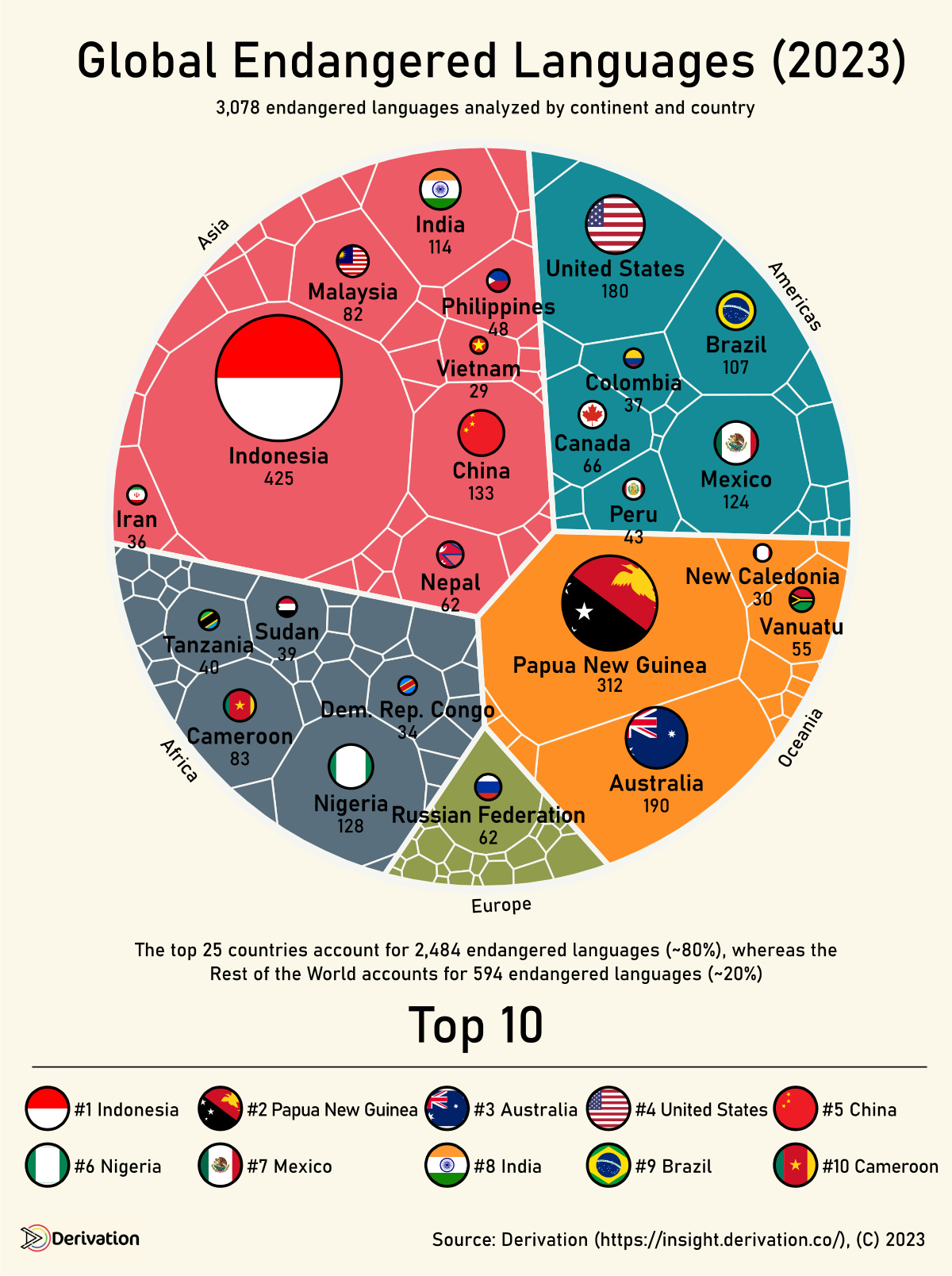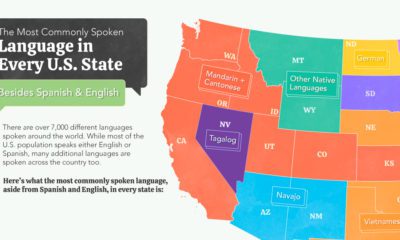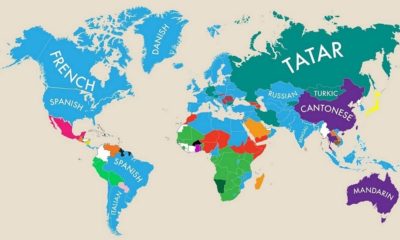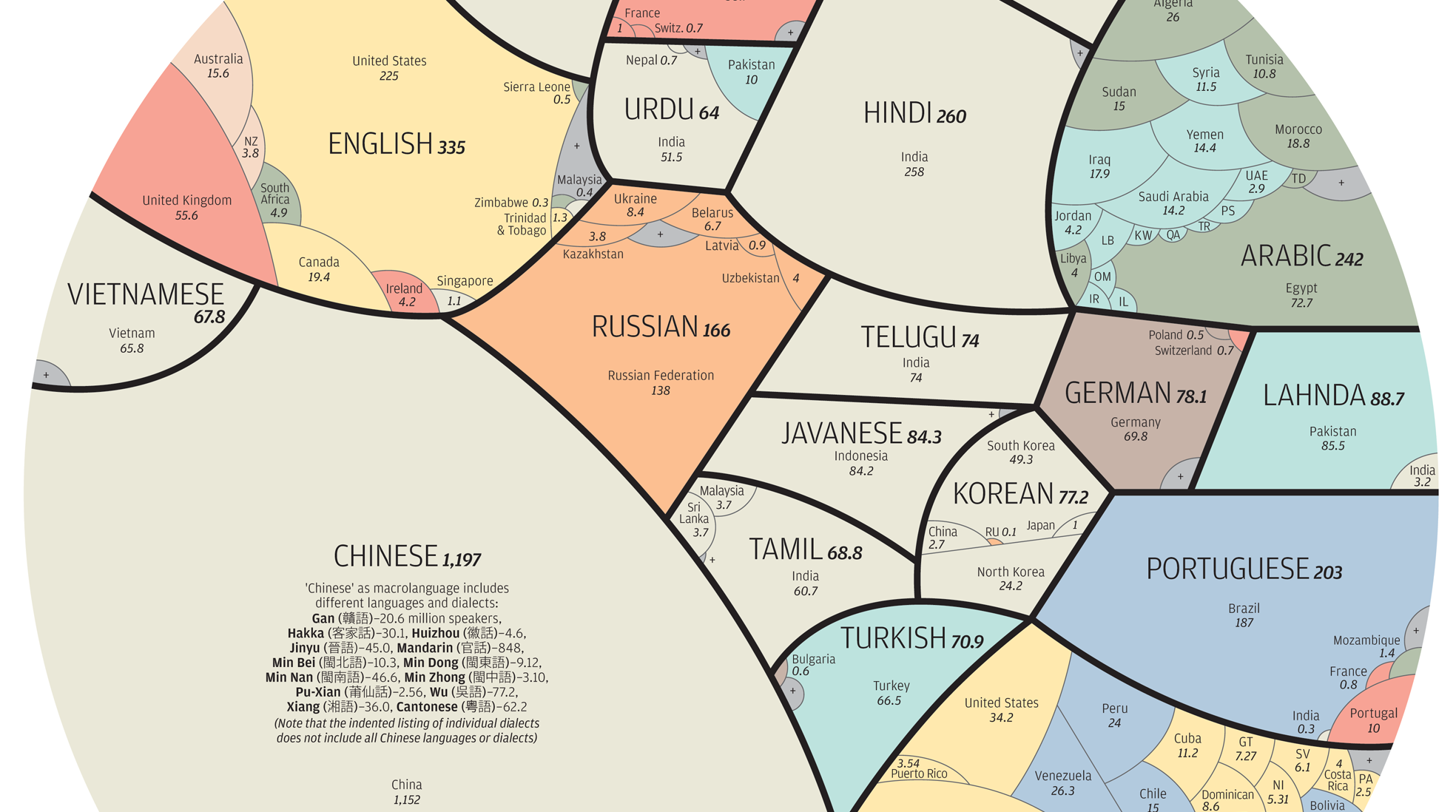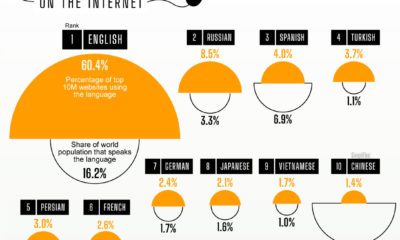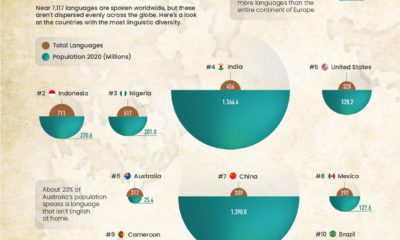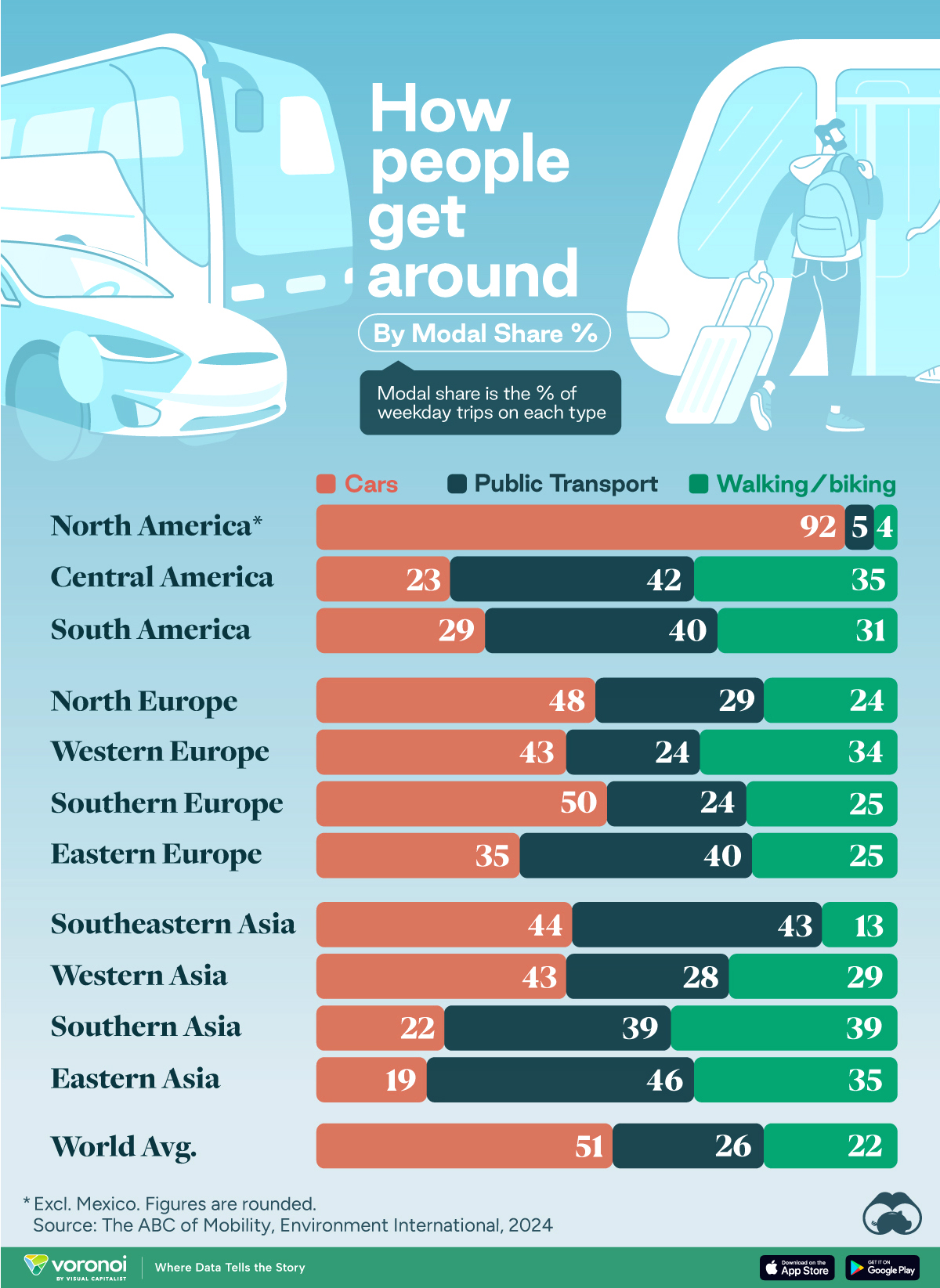Culture
All the World’s Endangered Languages, by Country
![]() See this visualization first on the Voronoi app.
See this visualization first on the Voronoi app.
Visualizing All the Global Endangered Languages
This was originally posted on our Voronoi app. Download the app for free on iOS or Android and discover incredible data-driven charts from a variety of trusted sources.
Almost half of the world’s approximately 7,000 signed and spoken languages are currently endangered.
This graphic, from Stephen Jones, CEO of Derivation.co, examines the current global landscape of languages that could become extinct.
Almost 90 million Speak Languages at Risk of Extinction
An extinct language is one that no longer has any first-language or second-language speakers.
In modern times, languages have usually become extinct due to cultural assimilation, leading to language shift, and the gradual abandonment of a native language in favor of a foreign language, primarily those of European countries.
For instance, numerous Native American languages were supplanted by English, French, Portuguese, Spanish, or Dutch due to European colonization of the Americas.
Currently, out of the world’s 7,168 living languages, 3,078 (43%) are classified as Endangered. Over 88 million people speak languages at risk of extinction.
| Locations | Endangered Languages |
|---|---|
| 🇮🇩 Indonesia | 425 |
| 🇵🇬 Papua New Guinea | 312 |
| 🇦🇺 Australia | 190 |
| 🇺🇸 United States | 180 |
| 🇨🇳 China | 133 |
| 🇳🇬 Nigeria | 128 |
| 🇲🇽 Mexico | 124 |
| 🇮🇳 India | 114 |
| 🇧🇷 Brazil | 107 |
| 🇨🇲 Cameroon | 83 |
| 🇲🇾 Malaysia | 82 |
| 🇨🇦 Canada | 66 |
| 🇳🇵 Nepal | 62 |
| 🇷🇺 Russian Federation | 62 |
| 🇻🇺 Vanuatu | 55 |
| 🇵🇭 Philippines | 48 |
| 🇵🇪 Peru | 43 |
| 🇹🇿 Tanzania | 40 |
| 🇸🇩 Sudan | 39 |
| 🇨🇴 Colombia | 37 |
| 🇮🇷 Iran | 36 |
| 🇨🇩 Democratic Republic of the Congo | 34 |
| 🇳🇨 New Caledonia | 30 |
| 🇻🇳 Vietnam | 29 |
| 🇧🇴 Bolivia | 25 |
| 🌐 Rest of the world | 594 |
| Total | 3078 |
Additionally, 100 of them face the genuine threat of extinction within a few decades if no action is taken.
While every language matters to the individuals speaking, writing, and signing them across the planet, 80% of endangered languages (2,484) exist within just 25 countries.
Of those, the top four countries alone – Indonesia (425), Papua New Guinea (312), Australia (190), and the U.S. (180) – account for well over a thousand endangered languages.
Just as during the colonization period, the majority of endangered languages are spoken in Indigenous communities, putting their inherent culture and knowledge at risk of loss.
Languages, however, can be revitalized.
Over the last 50 years, for example, government support to teach native languages in schools has helped increase the number of speakers of the Māori language in New Zealand, and Hawaiian in the American state.
Advancements in AI are also providing tools to preserve languages.

This article was published as a part of Visual Capitalist's Creator Program, which features data-driven visuals from some of our favorite Creators around the world.
Automotive
How People Get Around in America, Europe, and Asia
Examining how people get around using cars, public transit, and walking or biking, and the regional differences in usage.
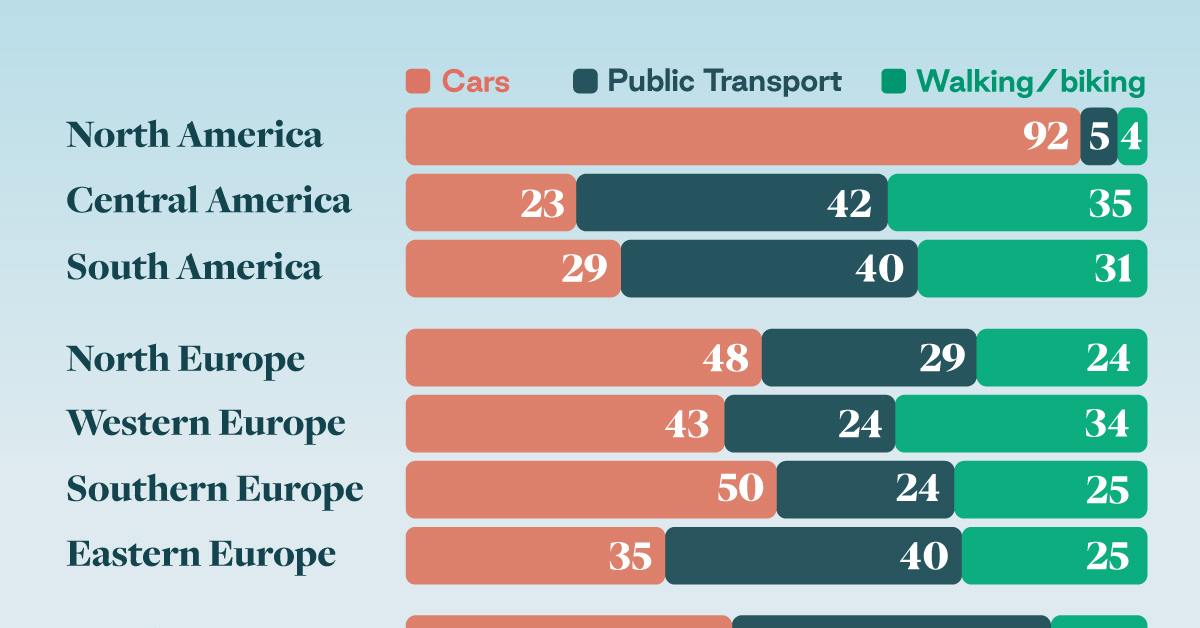
How People Get Around in America, Europe, and Asia
This was originally posted on our Voronoi app. Download the app for free on iOS or Android and discover incredible data-driven charts from a variety of trusted sources.
This chart highlights the popularity of different transportation types in the Americas, Europe, and Asia, calculated by modal share.
Data for this article and visualization is sourced from ‘The ABC of Mobility’, a research paper by Rafael Prieto-Curiel (Complexity Science Hub) and Juan P. Ospina (EAFIT University), accessed through ScienceDirect.
The authors gathered their modal share data through travel surveys, which focused on the primary mode of transportation a person employs for each weekday trip. Information from 800 cities across 61 countries was collected for this study.
North American Car Culture Contrasts with the Rest of the World
In the U.S. and Canada, people heavily rely on cars to get around, no matter the size of the city. There are a few exceptions of course, such as New York, Toronto, and smaller college towns across the United States.
| Region | 🚗 Cars | 🚌 Public Transport | 🚶 Walking/Biking |
|---|---|---|---|
| North America* | 92% | 5% | 4% |
| Central America | 23% | 42% | 35% |
| South America | 29% | 40% | 31% |
| Northern Europe | 48% | 29% | 24% |
| Western Europe | 43% | 24% | 34% |
| Southern Europe | 50% | 24% | 25% |
| Eastern Europe | 35% | 40% | 25% |
| Southeastern Asia | 44% | 43% | 13% |
| Western Asia | 43% | 28% | 29% |
| Southern Asia | 22% | 39% | 39% |
| Eastern Asia | 19% | 46% | 35% |
| World | 51% | 26% | 22% |
Note: *Excluding Mexico. Percentages are rounded.
As a result, North America’s share of public transport and active mobility (walking and biking) is the lowest amongst all surveyed regions by a significant amount.
On the other hand, public transport reigns supreme in South and Central America as well as Southern and Eastern Asia. It ties with cars in Southeastern Asia, and is eclipsed by cars in Western Asia.
As outlined in the paper, Europe sees more city-level differences in transport popularity.
For example, Utrecht, Netherlands prefers walking and biking. People in Paris and London like using their extensive transit systems. And in Manchester and Rome, roughly two out of three journeys are by car.
-

 Politics5 days ago
Politics5 days agoCharted: What Southeast Asia Thinks About China & the U.S.
-

 Misc2 weeks ago
Misc2 weeks agoVisualizing the Most Common Pets in the U.S.
-

 Culture2 weeks ago
Culture2 weeks agoThe World’s Top Media Franchises by All-Time Revenue
-

 Best of2 weeks ago
Best of2 weeks agoBest Visualizations of April on the Voronoi App
-

 Wealth1 week ago
Wealth1 week agoCharted: Which Country Has the Most Billionaires in 2024?
-

 Markets1 week ago
Markets1 week agoThe Top Private Equity Firms by Country
-

 Markets1 week ago
Markets1 week agoThe Best U.S. Companies to Work for According to LinkedIn
-

 Economy1 week ago
Economy1 week agoRanked: The Top 20 Countries in Debt to China

